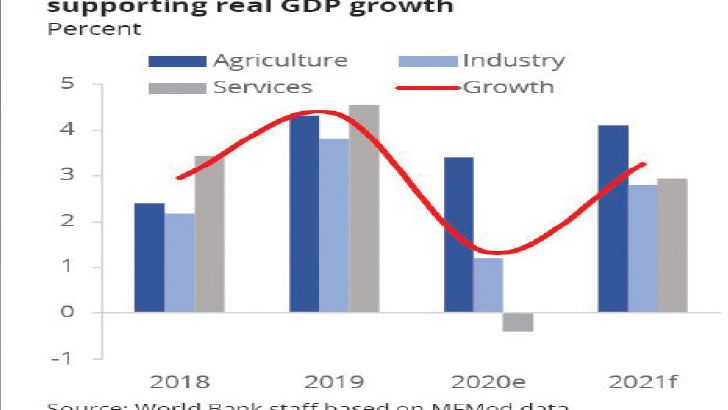WB slashes MW’S Growth prospects
The World Bank has revised downwards the country’s growth projections by 0.5 percentage points to 2.8 percent as Covid-19 impacts continue to bite.
In January, the multilateral bank projected Malawi’s economy to grow by 3.3 percent, from a growth of one percent the previous year.
However, at 2.8 percent, the projection is 0.7 percentage points below Ministry of Finance’s 3.5 percent forecast for the year.
In its April 2021 Macro Poverty Outlook (MPO), the bank said the growth estimates follow continued social distancing policies and low international tourist arrivals.

Reads the MPO in part: “The second wave of the pandemic which started in late 2020 has been more intense than the first and is further disrupting economic activity. Extensive input subsidies and favourable weather is expected to contribute to a one-time jump in maize production, which, combined with a pickup in tobacco production after 2020’s weak harvest, should lead to a strong agriculture performance in 2021.
“However, the vaccine is not expected to reach a significant portion of the population until at least mid-2022. As such, social distancing policies and behaviour are expected to weigh on economic activity and suppress domestic demand and only a weak rebound is expected in the services and industry sectors in 2021. International tourism, in particular, is unlikely to return to previous levels in the short term.”
President Lazarus Chakwera in his speech to Parliament last week noted that Treasury had also revised downwards the forecasts for the country’s economic growth from 4.5 percent to 3.5 percent in 2021, slightly higher than the projections made by the other institutions on economic growth rate of 2021.
Government’s 2021 revision is supported by the account of normal to above normal rains that the country has received so far, despite dry spells in some regions.
However, last year despite a robust performance in the first half of 2020 owing to a strong harvest and substantial government spending, the country’s economic activity in the second half of 2020 suffered from a further deterioration of the global economic outlook, resulting in substantially lower exports, a worsening economic impact of the Covid-19 pandemic and a further revised downwards its 2020 economic growth projections from 1.9 percent to 1.2 percent.
Lower growth rates of the economy will result in lower employment rates, due to slower industrial production and gains from retail sales, companies lower hiring to save money in the face of lower demand.
A low growth rate is also percent is worrying to the economy as it could further increase poverty levels, especially in the informal service sectors in urban areas, let alone in rural areas where the majority of Malawians live.
However, through the Malawi 2063, the country aspires to be an upper middle-income nation 42 years from now, with growth averaging six percent.
Ironically, the country’s growth has been volatile, ranging from as low as -7.3 percent in the aftermath of the 2001 drought and famine to as high as 9.7 percent in 2007, mostly due to the fiscal space created by full debt forgiveness under the Highly Indebted Poor Countries (Hipc) Debt Relief.
Finance Minister Felix Mlusu during his 2020/21 Mid-Year Budget Review indicated that economic growth in 2021 is dependent on how fast the pandemic will be overcome.




